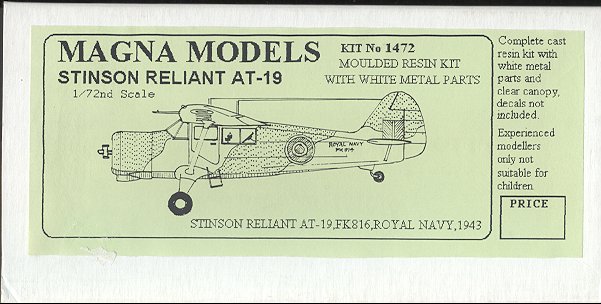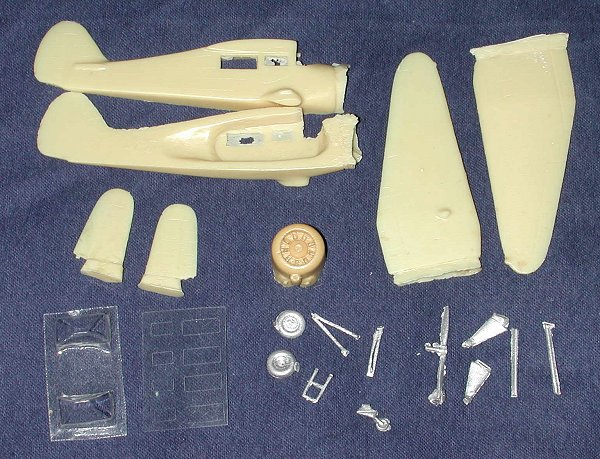
|
KIT: |
Magna Models 1/72 Stinson Reliant |
|
KIT # |
1472 |
|
PRICE: |
$38.95 |
|
DECALS: |
None |
|
REVIEW & |
|
|
NOTES: |
Resin kit with white metal parts |

|
HISTORY |
Amongst the many light planes impressed by the RAF during WWII, eleven of them were Stinson Reliants. These aircraft were utilized by various communications and training flights. Their main duty was transportation of individuals and parts from place to place, allowing the larger, purpose-built cargo and transport aircraft to be utilized more effectively. Rarely were any of these aircraft operated in an area where they could come into harms way. Often the only change from their civilian life were a coat of camouflage paint and perhaps a military radio.
The Reliant was a four or five seat executive aircraft powered by a 290 hp Lycoming R-680-13 radial engine. Production started in the mid-1930s and while civil production ceased, an order for 500 was received by the Royal Navy. The Royal Navy used them as instrument trainers with 722, 733 and 752 squadrons. In addition, Reliants were used in the US by the Army, Navy and Coast Guard. Like those of the RAF, the ones utilized by the Army and Navy were impressed civil aircraft. The Coast Guard had previously operated two planes since 1936. Several Reliants are still on the civil register. Civil versions can be distinguished from ex-Royal Navy planes by the smooth cowling of the RN birds.
|
THE KIT |

Opening the box, one is first taken by the thickness of the resin. Weak and wimpy this stuff isn't! The resin is, for the most part, well done with fine engraved panel lines and relatively clean castings. This cannot be said of the tailplanes. These are quite poorly done with one tailplane having a large number of pits in it and the other one having a mass of striated lines along the leading edges as well as a number of pits. The metal bits are done fairly well, though some of them have flash that will have to be removed. Two sets of vac canopies/windows are included. There is no interior nor are there any decals.
The instructions are adequate for the kit. There is a parts breakdown and a nice three-view to be used when painting the aircraft. Two different schemes are offered. There is also a good set of construction notes as well as a small piece on camouflage and several references. With the total parts count being 18 pieces plus the vac canopy, you'd think this would be a relatively quick build. Only time will tell.
|
REFERENCES |
Aircraft of the Royal Air Force since 1918 by Owen
Thetford
Jane's Encyclopedia of Aviation
Review kit courtesy of me and my wallet!
If you would like your product reviewed fairly and quickly by a site that averages over 3,000 visits a day, please contact me or see other details in the Note to Contributors.